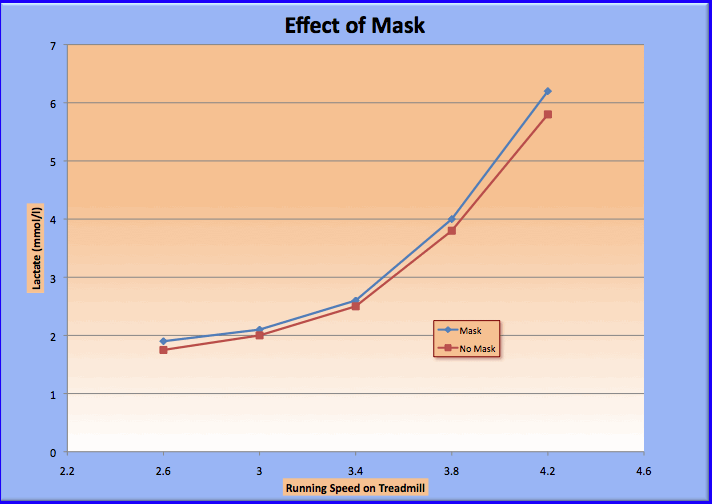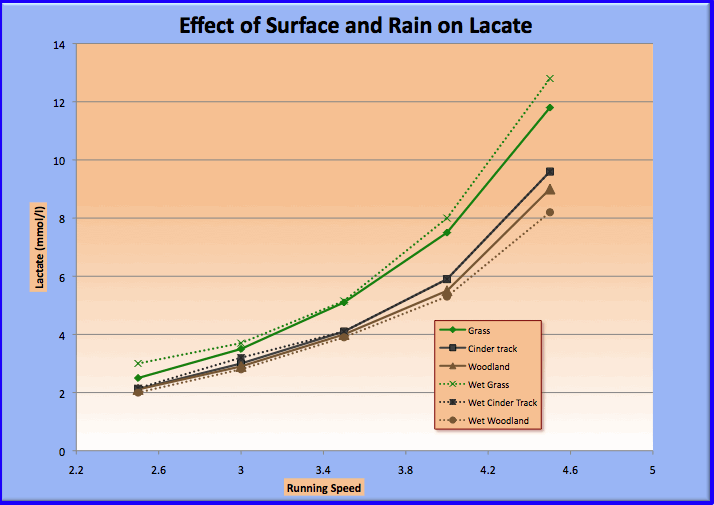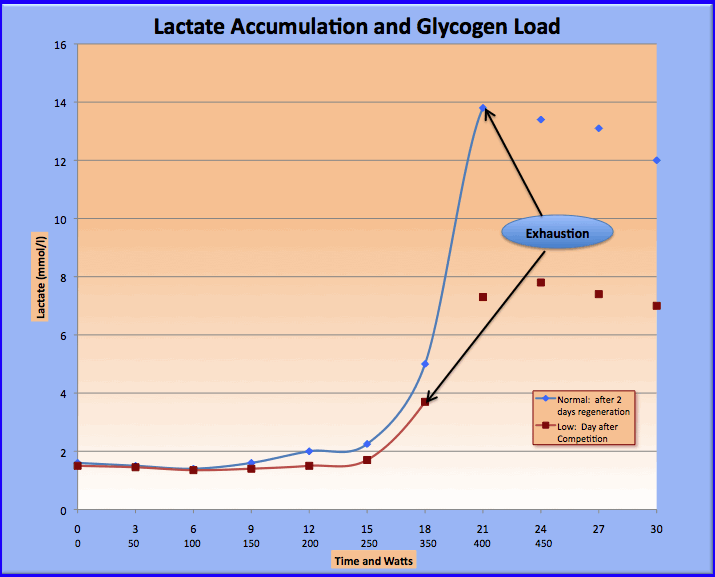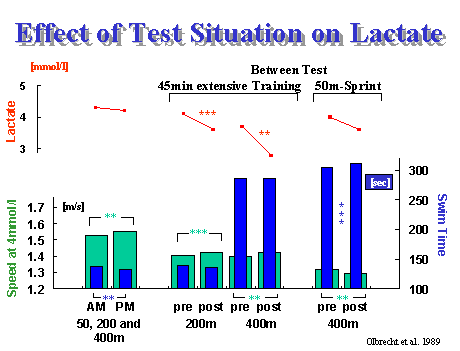Endurance Events and Lactate Testing
With Emphasis on the Triathlon
18 of 19
What else to consider
Influence of other variables on lactate test results
We have shown that athletes must test in the sport they are training for and that the structure of the test protocol (length of step and rest between steps) will affect results. The following discussion will point out how other variables can affect results.
Example 3A. Wearing a mask to measure oxygen-uptake during a test increases
the lactate levels slightly at each stage of the test. Thus, higher lactate levels will occur at an
earlier stage of the test.

Example 3B. Ground surface affects the lactate test results. Grass is a very healthy surface for run training. However, this surface absorbs a great amount of energy. This leads to an early accumulation of lactate compared to running at the same speed on other surfaces. The most efficient surface to run on at a moderate speed is a cinder track.

Example 3C. Also whether the surface is wet or dry will have an influence on
the test results. Energy increases dramatically if the grass surface gets wet. When a woodland track is
wet, running economy increases. The most neutral surface with respect to wet/dry interactions on lactate
test results is a cinder track. Similar results were also found for tartan tracks; for this reason we
recommend that all running lactate tests take place on a tartan track or a similar surface. The tartan
track is less slippery after a heavy rain and its surface is unaffected by heavy use. A cinder track can
become uneven if not maintained properly.

Example 3D. In swimming, the pool length substantially affects the results of a lactate test. The shorter the pool length the less lactate an athlete will develop at a given pace. Since swimmers vary greatly in their sensitivity to long/short course pools, it is very misleading to estimate for 50m-pool times from a test in a 25 yd/m pool. If you are forced to do so, then it is better to make an adjustment appropriate to that individual swimmer: take the differences in the athlete's best time for the same distance in different pools as an adjustment factor (e.g. if the 400m time in 50m pool is 5 sec slower than in a 25m pool, then the athlete should add 5 sec to the training times calculated on the basis of a lactate test in a 25m pool.) When comparing 25-yard pools to 50-meter pools, an adjustment has to be made for the distance as well.
Other factors affecting results
The preceding examples showed how different elements of the protocol can affect results. However, there are other factors associated with training and the environment that will influence results. It is important to avoid these other factors since they affect the results of a lactate test. If the testing is done under any of these conditions, this could lead to a misinterpretation of the test results. Such interactions may come from:
- Weight training within 24 hours before the test
- An intensive training session within 24 hours before the test
- Testing within 3 days after an exceptional training period, such as an intensive and/or voluminous training camp or a major competition
- Testing in the morning versus testing in the afternoon
- Too intensive or too voluminous warming up
We have learned from experience that the lactate response after weight training may be disturbed for as long as 24 hours. Lactate accumulation at a sub-maximal workload seems to occur at an earlier stage and the lactate concentration after an all-out effort remains under the expected level. Taking such a disturbed lactate response as a reference to determine the actual physical conditioning profile, the training efficiency and to develop training guidelines for the coming training period, will certainly be misleading.
A similar interaction, but less pronounced, happens if intensive water training precedes a lactate test within 24 hours before the test.
Example 4A. If an athlete has just finished a voluminous or intensive training period, the glycogen supply in the athlete's muscles will probably be decreased. This will lessen glycolysis activity, which is responsible for producing lactate. In such a situation, the lactate production will be decreased and result in a later onset of blood lactate accumulation, but result also in a lower maximum lactate level. The following chart illustrates what can happen after a competition.

Without knowledge that the test took place a day after a competition this test may give the impression that the athlete improved in endurance. In fact it is not the improvement of oxygen uptake (real endurance improvement) but a reduced capacity to produce lactate that causes the shift to the right of your lactate curve. So don't plan a lactate test immediately after a competition or heavy training session, but provide a 3-day regeneration period before testing. This will assure that changes in lactate response can be attributed to changes in conditioning.
We have also observed that in the afternoon an athlete can swim about 1 sec/100m faster for the same sub-maximal lactate concentration as compared to a morning session. This means that lactate tests should always be performed at approximately the same time of day. This is especially true with excellent swimmers where there is not much room for improvement since they are already strong performers. With elite swimmers it is necessary to know that small differences are really due to conditioning changes and are not the consequence of testing at a different time of day.
Example 4B. The following chart shows three things that can affect lactate tests. These are:
- Differences in lactate accumulation between morning and afternoon for swimmers. Consequently, don't test early in the morning.
- Excessive warm-up can depress lactate results. If the warm-up before the test takes too long (more than 60 minutes) lactate after a sub-maximal effort will be lower when compared to a normal warm-up.
- Avoid sprints before a test. Even a single sprint before a sub-maximal test will induce higher
lactate after the next sub-maximal swim.

Planning is key
If all these variables that interact with the test are to be avoided, then the coach or athlete needs to plan lactate tests well in advance. It is even preferable to plan lactate tests at the same time as the coach or athlete is planning important training sessions and rest phases, i.e., the phasing of the macro-cycle. One of the advantages of lactate testing is that it will not only provide an education for the athlete and coach but it will also impress upon the athlete the importance of timing of certain types of training. Too many athletes just do what seems to be best for them at the moment and don't plan their training in advance.
Lactate tests should be planned preferably during a rest week (most training plans have weeks that are lower in intensity than others in order to speed regeneration) or in the first week after a rest week. In addition all interactions as mentioned above should be avoided if possible or taken into account. However, training has the highest priority. This means that lactate tests are scheduled around the training program, but never change a training program to schedule a lactate test.
Conclusions - For good testing, coaches and athletes must
- Keep test procedures as constant as possible.
- Test in the same length swimming pool as where training takes place. (It's all right to test in a 25 meter swimming pool and train in a 25 yard pool but don't test in a 50 meter pool and train in a 25 yard pool or the reverse.)
- Carry out the run test in dry conditions and on a tartan track
- Avoid non-protocol related factors that can interact with lactate results. (weight training or intensive water training within 24 hours, other recent heavy workouts or camps, early morning testing, long warm-ups etc.) It is advisable to test after a rest day or a day of easy workouts.
- Plan lactate tests well in advance (together with phases of the macro-cycle) to avoid those factors that could interact with the test.
Again we repeat that these precautions are appropriate for any form of testing not just lactate tests.
Continue on to Module 19 on how best to use heart rates in training
